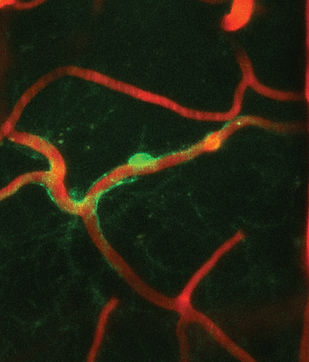Highlighted
pericyte Katp channels play a key role in neurovascular coupling
Isaacs D, Xiang L, Hariharan A, Longden TA. (2024). KATP channel-Dependent Electrical Signaling Links Capillary Pericytes to Arterioles During Neurovascular Coupling. PNAS. 121(50):e2405965121.
This paper shows that pericyte KATP channels play a critical role in controlling brain blood flow during neurovascular coupling.
Using optogenetic tools we demonstrate that pericytes can generate electrical signals that travel through the capillaries to upstream arterioles to cause vasodilation and increased blood flow, and we show that KATP channels are recruited to generate such signals rapidly in response to neuronal activation.

Press coverage
UVM Scientist Wins Chan Zuckerberg Initiative Grant to Tackle Neurodegenerative Diseases
Special Vascular Cells Adjust Blood Flow in Brain Capillaries Based on Local Energy Needs
UM School of Medicine Scientist Receives Prestigious NIH Director's New Innovator Award
How The Brain Controls Blood Flow With Calcium
Scientists Discover Electrical "Switch" in Brain's Capillary Network
Longden & Dabertrand’s Study on Capillaries’ Effect on Brain Blood Flow Gains National Coverage
Further publications
Fuller P, Collis V, Sharma P, Burkett A, Wang S, Brown K, Weir N, Goulbourne C, Nixon R, Longden T, Gould T, Monteiro M. (2024) Pathophysiologic abnormalities in transgenic mice carrying the Alzheimer disease PSEN1 D440 mutation. Hum Mol Genet. 33(23):2051-2070.
Lim X, Abd-Alhasee M, Ippolito M, Koide M, Senatore A, Plante C, Hariharan A, Longden TA, Laprade K, Stafford J, Ziemens D, Schwaninger M, Wenzel J, Postnov D, Harraz O. (2024). Endothelial Piezo1 channel mediates mechano-feedback control of brain blood flow. Nat Comm. 15(1):8686.
Longden TA, Lederer WJ. (2024). Electro-metabolic signaling. J Gen Physiol. 56(2):e202313451.
Longden T, Hariharan A, Zhao G, Lederer WJ. (2023) “Pericytes and the Control of Blood Flow in Brain and Heart”. Annual Review of Physiology, 85: 137-164.
Hariharan A, Robertson CD, Garcia DCG, Longden TA. (2022). Brain capillary pericytes are metabolic sentinels that control blood flow through a KATP channel-dependent energy switch. Cell Rep. 41(13):111872.
Koide M, Harraz O, Dabertrand F, Longden T, Ferris H, Wellman G, Hill-Eubanks D, Greenstein A, Nelson M (2021) “Differential restoration of functional hyperemia by antihypertensive drug classes in hypertension-related cerebral small vessel diseases” Journal of Clinical Investigation, 131: e149029.
Rosehart A, Longden T, Weir N, Fontaine J, Joutel A, Dabertrand F (2021) “Prostaglandin E2 dilates intracerebral arterioles when applied onto capillaries, implication in small vessel diseases” Frontiers in Aging Neuroscience, 13: 402.
Dabertrand F, Harraz O, Koide M, Longden T, Rosehart A, Hill-Eubanks A, Joutel A, Nelson M (2021) “PIP2 corrects cerebral blood flow deficits in small vessel disease by rescuing capillary Kir2.1 activity” Proceedings of the National Academy of Sciences USA, 118: e2025998118.
Hariharan A, Weir N, Robertson C, He L, Betsholtz C, Longden T (2020) “The ion channel and GPCR signaling toolkit of CNS pericytes” Frontiers in Cellular Neuroscience, 14: 423.
Garcia D, Longden T (2020) “Ion channels and Ca2+ signaling in the capillary endothelium.” Current Topics in Membranes, 85: 261-300.
Cleary C, Moreira T, Takakura A, Nelson M, Longden T, Mulkey D. (2020) “Vascular control of the CO2/H+-dependent drive to breathe in mice.”eLife, 9: e59499.
Mughal A, Sackheim A, Sancho M, Longden T, Russell S, Lockette W, Nelson M, Freeman K. (2020) “Impaired capillary-to-arteriolar electrical signaling after traumatic brain injury.” Journal of Cerebral Blood Flow & Metabolism, 41: 1313-1327.
Moshkforoush A, Ashenagar B, Harraz O, Dabertrand F, Longden T, Nelson M, Tsoukias N. (2020) "Capillary Kir channel as sensor and amplifier of neuronal signals: modeling insights on K+-mediated neurovascular communication." Proceedings of the National Academy of Sciences USA, 117: 16626-16637.
Harraz O, Longden T, Hill-Eubanks D, Nelson M (2018) "PIP2 depletion promotes TRPV4 channel activity in mouse brain capillary endothelial cells" eLife, 7: e38689.
Harraz O, Longden T, Dabertrand F, Hill-Eubanks D, Nelson M (2018) "Endothelial GqPCR activity controls capillary electrical signaling and brain blood flow through PIP2 depletion"Proceedings of the National Academy of Sciences USA, 115: E3569-E3577.
Longden T, Dabertrand F, Koide M, Gonzales A, Tykocki N, Brayden J, Hill-Eubanks D, Nelson M (2017) “Capillary K+-sensing initiates retrograde hyperpolarization to locally increase cerebral blood flow” Nature Neuroscience, 20: 717-726.
Tykocki N, Bonev A, Longden T, Heppner T, Nelson M (2017) “Inhibition of vascular smooth muscle inward-rectifier K+ channels restores myogenic tone in mouse urinary bladder arterioles” American Journal of Physiology Renal Physiology, 312:F836-F847.
Longden T, Hill-Eubanks D, Nelson M (2016) “Ion Channel Networks in the Control of Cerebral Blood Flow” Journal of Cerebral Blood Flow & Metabolism, 36:492-512.
Klitgaard-Povlsen G, Longden T, Bonev A, Hill-Eubanks D, Nelson M (2016) “Uncoupling of Neurovascular Communication After Transient Global Cerebral Ischemia is Caused by Impaired Parenchymal Smooth Muscle KIR Channel Function” Journal of Cerebral Blood Flow & Metabolism, 36:1195-1201.
Longden T, Nelson M (2015) “Vascular Inward Rectifier K+ Channels as External K+ Sensors in the Control of Cerebral Blood Flow.” Microcirculation, 22: 183-196.
Balbi M, Ghosh M, Longden T, Vega M, Gesierich B, Hellal F, Lourbopoulos A, Nelson M, Plesnila N (2015) “Dysfunction of mouse cerebral arteries during early aging” Journal of Cerebral Blood Flow & Metabolism, 35: 1445-1453.
Villalba N, Sonkusare S, Longden T, Tran T, Sackheim A, Nelson M, Wellman G, Freeman K (2014) “Traumatic brain injury disrupts cerebrovascular tone through endothelial inducible nitric oxide synthase expression and nitric oxide gain of function.” Journal of the American Heart Association, 3: e001474.
Longden T, Dabertrand F, Hill-Eubanks D, Hammack S, Nelson M (2014) “Stress-Induced Glucocorticoid Signaling Remodels Neurovascular Coupling Through Impairment of Cerebrovascular Inwardly Rectifying K+ Channel Function.” Proceedings of the National Academy of Sciences USA, 111: 7462-7.
Longden T, Dunn K, Draheim H, Nelson M, Weston A, Edwards G (2011) “Intermediate-Conductance Calcium-Activated Potassium Channels Participate in Neurovascular Coupling.” British Journal of Pharmacology, 164: 922-33.

